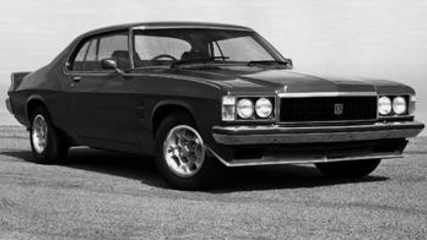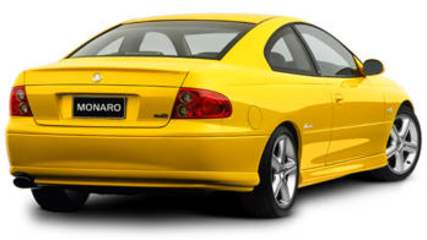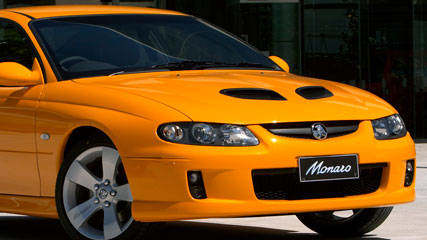Used Holden Monaro review: 2001-2002
By Graham Smith · 23 Jan 2009
Holden took everybody by surprise when it unveiled a slinky new coupe concept at the 1998 Sydney International Motor Show. The Commodore-based coupe was a well-kept secret and was the hit of the show.At the time of the unveiling it didn’t have a name, it was simply called the Commodore Coupe, but it wasn’t long before it was being called a new Monaro after Holden’s classic 1960’s coupe.Although there was some resistance to the name inside the company there was no denying public pressure and it was eventually decided to reprise the Monaro badge for the new millennium remake. A modern day classic was born.MODEL WATCHThe Monaro was launched in 2001 and remained true to the concept coupe. There were a few changes, but they were minor and barely noticeable.At the front, apart from a new grille and headlights, there was little to distinguish the Monaro from the Commodore, but rear of the A-pillars it was all new. The roof line was 40 mm lower and sleeker, the B-pillars were moved back to make the doors 150 mm longer, and the rear was shortened by 100 mm.Holden released two versions at launch, the supercharged V6 CV6 and the Gen III V8 CV8. Holden’s idea was that the Monaro would be a sophisticated grand tourer in the European mould and would attract buyers who didn’t necessarily want a thundering V8 under the bonnet.Unfortunately it would prove to be a miscalculation and the 171 kW blown six was an overnight orphan, and quickly dropped from the range as buyers flocked to the CV8.The V8 was the familiar 5.7-litre Gen III all-alloy V8 imported from North America. A pushrod design with two valves per cylinder the Gen III put out 225 kW at 5200 revs and 460 Nm at 4400 revs.Unlike the earlier Holden V8 the Chev unit was a high revver with less punch down low. When revved it would get up and go hard, but with the six-speed manual gearbox it could also be quite economical with a light right foot.There was also a four-speed auto available, which was less exciting, but meant you weren’t constantly shifting gears as you tended to be with the manual.Underneath, the Monaro was familiar Commodore, with MacPherson Strut front suspension and semi-trailing arm independent rear suspension.Brakes were discs all round, and ABS was standard along with traction control.Appropriately for a car at the upper end of the range the Monaro came fully equipped. Leather trim was standard, along with air-conditioning, cruise, 18-inch alloy wheels, trip computer, auto headlights, power seats with memory settings, and premium sound system with 10-stack CD changer.IN THE SHOPThe Monaro suffers the same problems as the mainstream Commodore. Owners report small glitches in power window winders, high mount brake lights coming adrift among the more common problems.The most concerning issue is with the Gen III V8 engine and the well reported piston rattle and oil consumption problems. Some engines suffer from piston rattle, best heard as a light metallic rattling noise when cold, others from high oil consumption, as high as five litres between oil changes, and others have both problems.Holden claims the problems affect around 20 per cent of engines, and claims to have fixed them by rebuilding problem engines with Teflon-coated pistons and reduced piston to bore clearance.Most owners are happy with the fix, while others report that the problem has returned after 30-40,000 km. Some engines have been rebuilt more than once.When considering buying a CV8 take the time to listen for the piston rattle, and ask the owner if the engine has shown any problems or been rebuilt.Once you’ve bought the car keep a close eye on the oil consumption with regular checks. If the engine is consuming oil keep a record of how much oil you add at what odometer readings.Failed supercharger nose bearings are common on the CV6, but changeover blower noses are available.IN A CRASHThe Monaro was fitted with driver, passenger and side airbags for comprehensive all round crash protection. It’s not included in the recent used car safety survey, but the VT/VX Commodore is and that rates significantly better than average for occupant protection, but worse than average in protecting others.OWNERS SAYWolf Haefele fell in love with the Monaro when he saw it at the Sydney International Motor Show. He loved its shape and thought it was the most beautiful coupe ever. He bought his in 2002. He’d only had Japanese vehicles before the Monaro, but was convinced to buy his first Holden after being invited to a Monaro drive day with Peter Brock. The Monaro handled exceptionally well, had plenty of power, but also had the trim and quietness of a luxury car. It has now 16,000 km, and has been very reliable; his only complaint is that the boot hinges eat up the cargo space.LOOK FOR• Head turning looks• Wild hero colours• V8 performance• V8 piston rattles and high oil consumptionTHE BOTTOM LINEStylish coupe with head turning looks, wheel spinning performance, and future classic potential.RATING80/100









